30th ANNIVERSARY SPECIAL FEATURE: A first-hand account of the 1994 Mt. Halcon tragedy
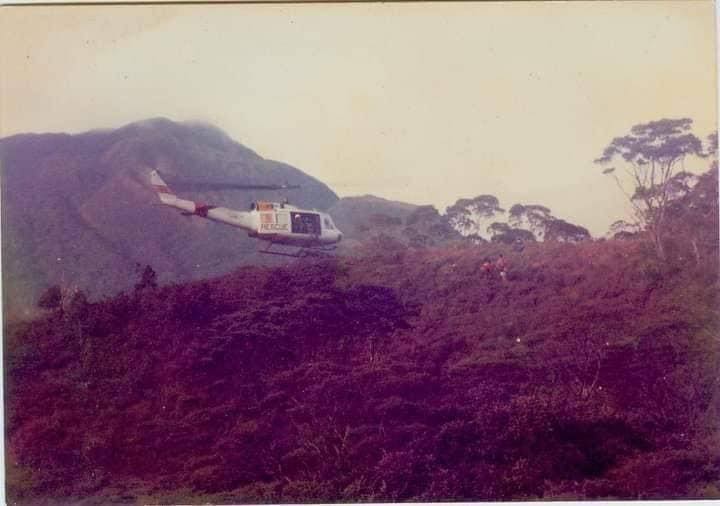
by Dominic Rover Ocampo, Sialdang Mountaineering Club (SMC)
edited by Eunice Novio, honorary member, SMC
Blogger’s note: In October 1994, a tragedy took place in Mt. Halcon that was described in our registry of hiking-related deaths as follows: ” At the height of Typhoon Katring, hypothermia claimed the life of Neptali Lazaro, 25, of San Beda. The exposed and hazardous conditions in Halcon was aggravated by the wind chill brought about by the supertyphoon. Other members of the climb were survivors of hypothermia.” On the 30th anniversary of this tragedy, one of the eyewitnesses, Dominic Rover Ocampo of Sialdang Mountaineering Club (SMC), shares his first-hand account with the editorial assistance of Eunice Novio, honorary member of SMC. We are honored to publish his full account:
The Outwards: October 13, 1994
The wind is howling continuously, and my feet are moving fast, scrambling along the trail. I could barely see the summit from my location, within 200 meters. The pouring rain is darting over my head, my hands are starting to numb while adjusting the straps, and the weight of my soaked-wet backpack is increasing. The struggle to reach the summit camp is too long this time. Unlike my previous hikes, this could be ominous.
I reached Camp 1 Aplaya ahead of time. It was around two in the afternoon. I slowly dragged down my backpack on the sloppy timberline and sat on an old, protruding root of a tinikaran tree. I stayed there for a couple of hours. I was mesmerized by the view of the summit. The blue sky was visible with patches of clouds on the northern ridge of this beautiful mountain. The weather and the view at this campsite were among the best in the country’s mountains. It was peaceful, and the rows of trees descended to the Dulangan River and ascended to the majestic curtains of waterfalls below the summit.
I got ready to cook rice as early as I always did on my eighteen travels to this location while I waited for the other trekkers. The calming aroma of rice and coffee has made the long days disappear. When the remaining hikers finally arrived at 6 p.m., I told them to relax while having dinner. The nightly gatherings had been incredibly happy, with everyone laughing and grunting aloud before going to sleep.
The peaceful night was good enough to rest after twelve times setting foot on the summit of Mt. Halcon. I smiled, looking up at the ceiling of my tent. I was glad that I had another shot to climb this season. This would be my last climb this year.
Mount Halcon, aka Sialdang, is known for its pride and is regarded as the toughest hike in the Philippines, or “Mighty Sialdang”. It is also one of the most scenic and underrated hiking trails, making it attractive to outdoor enthusiasts from around the country. Mt. Halcon is the eighteenth highest mountain in the Philippines, located on the island of Mindoro. Its elevation of 2,616 m (8,583 ft) was first escalated on April 28, 1978, by the Sialdang Backpackers. The group of hikers were Asterio Valino Tecson, Efren Garcellano, Teodoro Infantado, one friend from Laos, and four Mangyan porters from Naujan. The total hours of travel from Manila to Lantuyang are estimated to be three to four hours.
I was an early riser. I grabbed the whistle and blew one long blast to wake up the others in my group, the Sialdang Mountaineering Club (SMC). As an expedition leader, I instructed them to arrange breakfast for that day. It would be our last day on the mountain after such a successful induction event on the summit.
It was the first induction of the group, with 21 new official members, including me. The group members were athletes from the Divine Word College of Calapan—the football team, sepak takraw, badminton, and track and field. They also played for national events. As president of the group, I reminded them to maintain their fitness. They should not forget to train before the next annual climb in October. They all nodded in agreement as we began our breakfast.
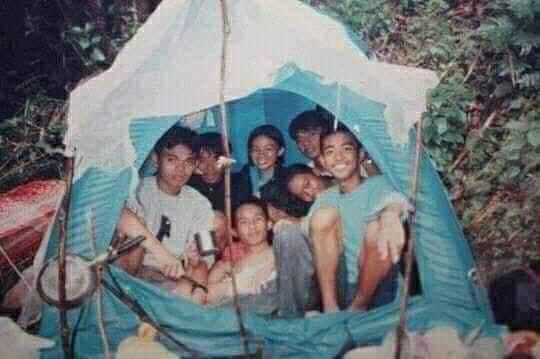
The Window: October 19, 1994
Despite the position, I cannot see everyone. As I move closer to the summit, I am beginning to lose control of my agile body. I know it is closer, but I cannot find the spot where the spot is. All I can see is water before my eyes, the gray and black horizon, and the cold grasses and low-lying vegetation at my feet. As I turn my gaze towards the earth, the rocks turn white.
Six days after the descent from the annual climb, I unpacked my backpack and washed the laundry. Recovering is much more difficult than preparing and climbing properly. After the strenuous hikes to the toughest mountain, surprisingly, it is more difficult to clean the hiking boots and other gear.
Usually, I would stop by John Lopez’s outdoor store, SIGU, when I had some free time in the afternoon. John was a member of Sialdang, and we have been friends since high school. SIGU is right on the next street, not too far from where I live. I noticed that there were a group of people sitting in the gutter with their backpacks. I was confused and asked John about their being in town. He said that they were going to climb Mount Halcon, but I explained that the group’s yearly climb had already been completed and that climbing season is not possible for the upcoming weeks.
The two outdoor groups, MESAU (Mountaineering Exploration Society of Adamson University) and Bedans (from San Beda College), would like to be accommodated by SMC. I reluctantly agreed, although SMC had done the annual climb, and I had not recovered from the previous ascent.
John said that the two groups and another hiker from UPLB sent a communication letter to another local mountaineering club. However, when the groups arrived, the local mountaineering club, for unknown reasons, refused to accompany them on the climb.
John introduced me to the group of visitors from Manila. I met their team leaders, who were newbies to Mt. Halcon. Ronald Parlan was the team leader from MESAU, Sonny Balagasay was the MESAU President, and Bong Ramos was from Bedans. The lone visitor hiker was Grace Villamor from the University of the Philippines, Los Banos (UPLB). She eventually requested to be adopted by Sialdang MC. She wanted to climb the summit alone, but fortunately got a chance to be on the expedition.
I was still surprised by the turn of events. It was also the first time our group managed the climb with mountaineering organizations from Manila. Bino Abas, the vice president of SMC, checked the PAGASA weather forecast for the week. The forecast stated that the weather was safe enough for the climbers to try and reach the summit with no rain showers or thunderstorms. I relied well on his report and was glad about the “window” for the summit climb.
John and Bino confirmed that they would follow on the third day after settling their business first. I was relieved by their assurance and the favorable weather forecast, so I once again began packing for the trek.
All the visitors had never set foot on Mt. Halcon before. They said they had trained for this tough mountain and had climbed numerous mountains, both minor and major climbs, before deciding to pursue this one. However, the Bedans honestly told me that they were also newbies to the known terrain of Mt. Halcon. They had often climbed mountains outside Manila and were best buddies at the university. One of their members, Michael Robles, was from Calapan and had friends among numerous Sialdang members. He invited his uncle, Nephtali Lazaro, to be on their team for the summit adventure and to fill out the eight members of their team.
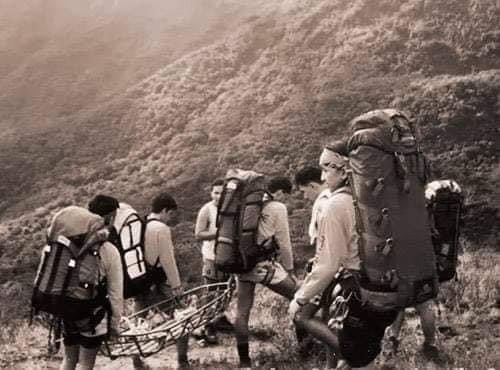
The Expedition Leader
I can see the summit in the distance, only fifty meters away. The wind is fierce and the rain relentless, making the climb even more challenging. As I approach the summit, my foot slips dangerously close to the steep ledge. I fell to my knees, exhausted and frustrated. The wind is so loud that I can’t even hear my own voice. I need to find a way to overcome these harsh conditions and reach the summit safely.
The group, which included nine Sialdang MC hikers, moved to the Lantuyang jump-off point. We settled near the river, pitched our tents, and cooked our food for the night. Ronald requested that the team leaders of each group have a meeting on the riverside to choose an expedition leader (EL) for the three groups, which had a total of thirty participants. As the most experienced climber among us, I was chosen to be the EL for the duration of the climb.
Before this mid-year climb in October, I had already summited Mt. Halcon twelve times and made it halfway to the summit six times. The halfway point refers to reaching either Camp 1, 2, or the Summit Ridge. There were also times when I climbed just to stay and relax at either Camp 1 or Camp 2 on the Dulangan River. My experience made me confident that I was the right person to lead their expedition up the mountain. While I agreed to be their leader, I made it clear that their safety was my top priority and that they must follow my commands.
The evening was clear, and the stars shone brightly, as if approving of my presence. The dark river reflected the light emanating from the fireflies. After dinner, I retired to my tent early, gathered my sleeping gear, and laid down. I knew I had to go to sleep early for the task ahead tomorrow. Memories of this mountain flooded my mind, reminding me of my personal growth and development. Mt. Halcon has helped me become a stronger person, and its trails have transformed me into a new version of myself with every hike I complete.
The Sunny Day: October 20, 1994
I greeted Neph. He was sitting and refreshing beside the water’s edge, with his feet dipped in the cool water. He smiled at me and said that he had something to give me as a token of joining him for a climb. He handed me a purple T-shirt and gave me a brotherly hug. I thanked him for his thoughtful present. Purple is a color that represents wisdom, devotion, and grandeur.
Early in the morning, I blew a long whistle blast to wake everyone up and remind them to have breakfast soon. I walked quickly from one tent to another to be sure that everyone was following the itinerary. After the camp break, the group gathered for a short prayer before starting to move in a loop. The group was divided into three subgroups: the lead pack, the middle, and the sweeper. I chose to be the sweeper to ensure that no one was left behind. It was important to me that everyone in the group stay together.
Before the sun rose, we started our morning with some calisthenics. We resumed our trek, passing through a Mangyan village and marching along the upper trail of Lantuyang. In the 1990s, there were no local porters or guides being paid for the journey, so local mountaineers served as our guides. They provided us with packs to carry all the necessary items for the mountain. Strictly following the self-contained approach of adventure has been imbibed as a true mountain dweller for these leisure activities. Thus, the Mangyans have never joined the mountaineers. You carry your backpack and enjoy the thrill of adventure.
I instructed the group leader to regroup for lunch at the third water source. The sun was blazing hot, and we could feel its intensity. However, we all enjoyed our meals. Some of us even stayed in the water to refresh ourselves from the heat of Lantuyang at the lunch camp called Aygatol, or the water source.
The groups proceeded to the rugged terrain of Mt. Halcon. As a local hiker, I take pride in referring to Mt. Halcon as my mother mountain and my humble abode since 1991. Climbing the summit frequently has developed my physical and mental strength. I relish being in the forests, hitting the trail, and exploring the uncharted areas of this mountain. One of my most unforgettable experiences was exploring the Big Waterfalls located on the eastern wall on July 28–31, 1992.
At about five in the afternoon, all the groups were in Camp 1Aplaya. They were all safe and sound. We had short-hour socials to get to know each other well. We shared some stories about training and the mountains I had climbed. I told them that Mt. Maculot was my favorite mountain after Mt. Halcon. They laughed at me and asked why. I told them that Maculot is the highest mountain in the Philippines and will never be Mt. Apo. They laughed at my funny punchline.
The Hikers: October 21, 1994
I am praying hard. I have climbed this mountain several times, even during bad weather. This included my first climb on April 25–28, 1991. But this time, I am more than terrified because of my responsibility to these people with little experience in mountain survival. If I am miserable at this moment, how much more are these first-timers, especially the visitors from Manila?
The sun broke out early this morning, and the cool weather made us do some stretching to warm up our bodies. Other groups were preparing their breakfast and their packed lunch. Sialdang members discussed the possibility of reaching the summit camp in the afternoon. Aplaya, or Camp 1, is the best spot for the newbies on the first day of the trek up Mt. Halcon. Dulangan River, or Camp 2, is only fifteen minutes away from Aplaya and is an optional camp for fast-paced hikers who would like to advance their itinerary and pitch their tents near the riverbank.
At seven o’clock in the morning, the hikers resumed hiking down the river. Dulangan is a major water tributary with an existing campsite developed since1986. In the past, I used to camp here in advance on the first day and pass the river after the arduous hike to Camp 1 on the third day. The river is dotted with sizable boulders, splashing rapids, and blueish pools that add to its natural beauty. River trailing is an enjoyable activity and provides easy access to another campsite near the mossy forest. The Mangyans built this campsite when the river was inaccessible during the monsoon season from June to November.
The group took a ten-minute break to eat their trail snacks before heading to the flatland mossy forest. I instructed the group to regroup at the next spot, Balugboy Baboy, to check on the last members on the trail. The tormenting heat of the sun made the hike difficult because this area is an open space covered with thick bushes. Lightning strikes often occur here, leaving visible fire markings on dead trees.
After the regrouping and small talks, I designated myself to be in the middle group to manage both the lead and the sweeper. They agreed to my suggestion, and we continued the trail towards numerous waterlines and finally to the last water source called Anglo.
Anglo is one of the waterlines on Mt. Halcon. It is usually the lunch area on the second day when climbing the summit. It is known as the last water source and a lunch camp, as well as a resting place before the assault on the steep, loose rocks to the Azotea. At Anglo, hikers fill their water containers that will be used on the summit and for the next day’s consumption. After an hour’s stay, I gave an orientation to all hikers, explaining the three major waypoints to be used as campsites: the Summit Ridge Camp, the Mini Forest near the ladder, and the Summit Campsite passing the knife-edge section. It was clear to them which waypoints and campsites to utilize in case of emergency situations. The Mini Forest is designated as the emergency camp if needed.
The Azotea is a clearing section overlooking wide forested areas, mostly primary forests and old bamboo forests. Azotea is called Pakol. In 1992, during my first year of climbing, a Mangyan village could be seen from Azotea or from the balcony. One could clearly see the villagers and their kaingin atop the village. Hence the moniker, Azotea.
The group recommended following the trail. I myself took most of my time to rest before the steep trail to the summit ridge. I felt the enveloping coolness of the air as it is usual on the ridge because of its location. The ridge is a place of emotions. You could view the magnificent mountains in the eastern section and, on the west side, the Occidental Mindoro. The ridge is just a small campsite with trees surrounding the area. I ordered the lead and middle groups to proceed to the mini-forest and regroup there. The sweeper would follow.
The Distressing Moment: 6:00 PM (October 21, 1994) to 6:00 AM (October 22, 1994)
“We drag Mike towards the summit camp while also carrying him when needed. The strong wind prevents us from walking quickly. We are weary and tormented.”
The wind started to swirl in every direction, causing the ridge trees to sway violently. Sudden gusts of wind made it difficult to move forward. I looked up and saw a flurry of clouds developing uncontrollably. I couldn’t see anyone else from my position, so I had to step forward along the thick forest. I grabbed onto branches to hold myself steady and pushed my way in the southern direction. The edge was tough this time, and it hurt my body as I slithered through the forest.
Then, I saw the middle group. My friend Ian Tecson is sitting on a mossy branch. I instructed him to stay in the forest and wait for the last group. I worked fast to reach the lead group and warn them of the danger of mountain depression. I was confused as to why they did not follow the regrouping plan and instead pushed themselves toward the summit. The situation was already dangerous for the hikers heading to the summit campsite. I was trying to reach them, but the strong winds and rain deterred me. They were too far from my location.
I was aware that they were struggling in the stormy weather too. As soon as I opened myself to the ladder section, I felt the instant blow of strong winds and heavy rains darting down my face. The ladder section is an open area along the cliff with a narrow wooden plank attached using wire and rattan. Ian Tecson was in the middle group, and he managed to control the hikers to stay in the forest, where safety is his foremost concern. Ian is the son of Aster Valino Tecson and the adviser of Sialdang MC. Sir Aster was one of the first explorers to reach the summit of Mt. Halcon on April 24, 1978.
Hiking along the Knife Edge is dangerous, and I saw some hikers struggling toward the summit from time to time. However, I had difficulty reaching them at once due to the continuous howling wind. My feet were moving fast, scrambling along the trail, but I could barely see the summit from my location within 200 meters. The pouring rain darted my head, and my hands started to numb while adjusting the straps, tarnishing the weight of my soaked-wet backpack. The struggle to reach the summit camp was too far this time, unlike the previous hikes that were remarkably enjoyable.
I was high up in the mountains, but the visibility was zero. I struggled to maintain control of my agile body as I made my way toward the summit. Even though I knew it was close, I couldn’t see anything beyond the gray and black horizon that loomed before me. The cold grasses and low-lying bushes beneath my feet were barely visible through the water in my eyes. As I looked down, the rocks slowly turned white. There was no turning back now. I pushed myself to keep going, determined to reach the summit and join my fellow hikers. As I approached the summit, I saw some other hikers on the trail. I instructed them to move quickly so we could pitch our safety tents. Our last resort for safety in this extremely open space was to huddle inside the tent. We were less than fifty meters away from it, but the wind was howling, and the rain was relentless. It pushed me away from the summit, making it difficult to move forward. Suddenly, my feet slipped near the edge of the summit, dangerously close to a steep ledge. I stumbled and fell to my knees at the summit campsite. Exhausted and out of breath, I tried to yell for help, but the sounds of the wind drowned out my voice. I knew I had to do something better than just compete with the wind and rain.
Upon stumbling on the ground at the summit camp, I regained my strength and yelled, looking for the tents. I desperately asked everyone about the tent’s location. After locating the big dome tent occupied by seven people, I pitched it alone. I also managed to pitch two more small tents for the other climbers. Although exhausted and worn out, I managed to pitch all three tents in just a few minutes. After checking back and forth to ensure that everyone was safe inside the tent, I finally got inside. Ian came along as the last person to be at the summit; he said that he stayed at the mini forest for an hour and decided to just hike to summit camp to be with the lead and middle pack.
However, the heavy rain and wind continued to bang against our tent. We said prayers. We took off our upper clothing, sitting back-to-back to adjust our body heat and circulate it inside our substandard shelter. Unfortunately, the tent was not durable enough to withstand the rain, and it started to flood inside. We took our clothes and dipped them into the flooring, squeezing them into the tent’s door. Our bodies were shaking. We could feel each other’s shivering. I checked my backpack and found one jacket wrapped in plastic. Although I wanted to use it to relieve myself from the numbing cold, I hesitated since others had no dry clothes with them. As darkness fell, the surroundings became dark and frightening. We continued praying for our safety while trying to keep warm inside our flooded tent.
Ian Tecson, being wary about the situation, asked for permission to double-check the surroundings. I wondered why he wanted to go back amidst the storm. He instantly expelled himself out of our tent, hit the trail exposed to harsh weather, and eventually reached the Knife Edge until the ladder section.
The continued prayer echoed in the mountain. Suddenly, I heard someone yelling and calling my name from a distance. It was Ian. Alarmed, I signaled the group to stop their prayers so that we could learn what message Ian had for us.
Death amidst the storm
Ian called my name again. He was shouting, “Somebody died on the Knife Edge!” He repeated it several times. Urgently, I got out of the tent, my heart pounding. Like a blind man, I touched the ground with my hands, searching for my shoes. I picked up somebody’s shoe that was too big for me and had no pair of socks. I quickly laced it up and asked if anyone was willing to join us in rescuing others, but no one came out of the tent. Ian and I decided to go back to see others on the trail. After several minutes of waiting outside, no one joined us. Bong, a Bedan, peeked from the tent’s door and volunteered to join us in going back to the Knife Edge and ladder. The three of us walked fast and ran impetuously with a flashlight, facing the dark night, somber and muted in great fear. Exhausted and cold, I realized that I had forgotten to grab my jacket to cover my thin body, except for a flimsy purple T-shirt that Neph had given me as a token.
As we walked through the cold and wet terrain, we found a body lying on the ground. Ian held him firmly while I walked over to Neph’s body. I checked his wrist and neck, but there was no pulse. My head throbbed with pain, and my heart sank with horror. The strong wind blew us around, and the rain relentlessly poured down on us. I instructed Ian and Bong to put Neph into a sleeping bag and zip it up to his chest. We found a thick bush and placed Neph underneath the bonsai trees on Knife Edge ground, as his temporary resting place. I whispered, “Sorry, Neph, we will be back for you soon.” We cried as we watched Ian cover Neph in a sleeping bag and shelter him in a thick bonsai forest away from the trail.
Ian confessed that on his way back for the two hikers, he discovered Neph’s body beside an open backpack with scattered gear. Ian applied CPR to alleviate Neph’s hypothermia and noticed that his jaw was locked out of position.
However, Ian was tasked with controlling the mini-forest section so the hikers would not pass through the area during the assault. After realizing the gravity of the situation, he insisted the hikers stay in the mini-forest and make an emergency camp for their safety, but he couldn’t convince the two and left. The hikers still followed the trail despite the vicious weather. Neph and another hiker couldn’t stay in the mini-forest. They were supposedly in the sweeper group, and now they wanted to push for the summit camp.
After thirty minutes, Ian decided to check on the two hikers. He climbed the ladder above the edge and followed the trail until he saw the two hikers. He repeatedly insisted on going back to the mini-forest, but he failed to do so. The two hikers remained on the trail, dragging themselves to be with the other Bedans at the summit camp. In the same manner, Ian pushed himself ahead for the summit camp too.
Neph had a company. I asked Ian about the other hiker and where he was. We urgently checked for other hikers on the trail and found one. It was Michael Robles (Mike), lying face down on the ground, exposed to the deadly natural elements. When the body loses heat faster than it produces, hypothermia can occur. Bong and Ian, who were stronger and sturdier than me, helped Mike stand up. Although he was frail and vulnerable, he was still alive.
I whispered to them to turn off their flashlights when we passed by Neph’s remains. Neph was Mike’s uncle and a guest hiker from Bedans.
We slowly dragged and carried Mike towards the summit camp, tormented and tired by the wind pushing against us. Mike gave clear directions to pass to the Knife Edge down the cliff, but he then began murmuring more words and became assertive that he was the real Superman, wanting to jump and fly off the cliff. It was apparent that Mike was experiencing a hallucination. When we reached the summit camp, I shouted to the hikers to open the big tent for us. Inside, Maureen Briones cut off Mike’s clothes while others massaged his body to help with circulation. We encircled Mike’s position, and I remembered that I had one last dry jacket, which I gave to him to relieve the hypothermic stage. I couldn’t stretch my legs, so I moved to Sonny Balagasay’s more durable and spacious 2-person tent for the night. It was a sleepless night for all of us until the sky became light and clear. As an EL, I was worried and bothered about how to explain this tragedy to the world. In my mind, I wanted to quit my life, but being here on this mountain, tragedy reminded me that I still have a purpose as an EL.
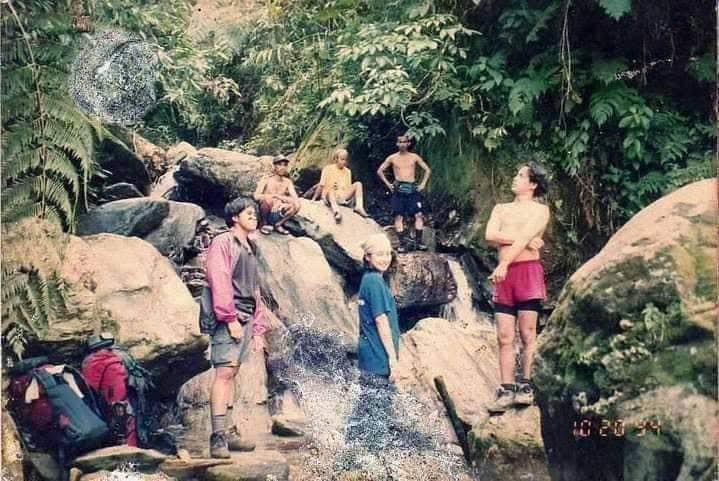
The Obstacle: October 22, 1994
We could never be able to push through to descend. A newly formed landslide barricaded us; a huge rock and boulders are within the trail.
At 7:00 in the morning, the gusty sky was turning light and gray. Suddenly, the wind became normal again. I checked on Mike, who was sleeping and in bad shape on the big dome. I talked to the summiteers and instructed them to wait and stand by for my orders to descend from the summit. The summit camp was traumatic, and I was weak too. However, as a leader and experienced hiker, I wanted to show that I was strong and capable of leading them to safety for the rest of the expedition.
The group started to pray again when suddenly, the loud voice of one hiker shouted that there was a dead hiker on the Knife Edge. It was William Driz, a Sialdang hiker, who did not know that the dead body was Neph, his uncle. I asked one hiker to get out of the tent and remind William to stop shouting about what he saw on the Knife Edge.
William was from the sweeper group, and I learned that they stuck together and made camp on the summit ridge safely. The sweeper group hiked towards the summit that morning and found Neph’s body.
At ten o’clock, Mike was awake. I asked him if he could walk, and he nodded. I instructed the group to wait for my signal before breaking camp. As I observed the surroundings, I gazed at the sky and noticed the leaves of the bonsai forest swaying in the southern direction, where the wind passed by the ridge. Despite my knees jerking from tiredness and the cold, I knew I had to walk towards the summit.
We broke camp and began descending to Camp 2 (Dulangan River) according to our planned itinerary. We decided to leave Neph’s body on the Knife Edge, ensuring that Mike wouldn’t come across it. The reason for leaving Neph’s body on the Knife Edge was to prevent Mike from seeing it. The decision was made to keep the story hidden from him, as carrying Neph’s body would only add to the already unstable situation of the expedition. Additionally, before passing Neph’s position, Lyndon Martillano and two other hikers were instructed to go ahead and make sure the body was hidden and out of sight so that Mike wouldn’t see it when he passed by along the trail.
On the ladder, we all descended carefully until we reached the mini-forest camp. There, we met Rilen Sanchez from Sialdang MC, as well as two male Bedans named Jordan Lauriano and Nicco Paraiso. They informed us that they had camped there and decided not to push for the summit that night. The entire group then descended to the summit ridge and regrouped.
Mike asked me about his Uncle Neph. I reluctantly told him that Neph was already in the lead group with some other hikers. I mentioned that his uncle was stronger than me. Mike nodded and smiled at me.
After regrouping, the whole group started to descend to Anglo. However, the weather became harsh again. The rain hampered the trail, loosening the soil and making it slippery. Water flowed incessantly along the trail, creating stronger rapids. It became difficult to find stable footholds in the muddy water, and visibility was reduced. As a result, I became wet and cold once again. Our backpacks already doubled in weight due to the absorption of rainwater.
In December 22–24, 1992, I made my first solo attempt at the summit ridge. It was never easy to cross the tributary of the Anglo River. The river tributary would overflow if it rained continuously. Once I got stranded and couldn’t cross. In order to cross the river, I had to wait two hours for the rain to cease. I had the Anglo tributary in mind. How might we cross this part of the trail or any other water tributaries? Mt. Halcon has many water lines. Even the trails were flooded during monsoons.
After two hours, the entire group made it to the last water source, Anglo. Mike questioned me once more about his uncle Neph. I said that he shouldn’t worry about his uncle’s absence because he was OK. He was at the advance party with some Sialdang hikers in Camp 2. He nodded.
We continued to make our way down to the designated campsite despite the constant rain. Along the way, I spotted Rilen Sanchez and a Bedan named Alex again. Rilen usually joined me while I trained in Calapan City each morning by running and climbing stairs. I invited her to accompany me. She disagrees hesitantly. She promised to arrive shortly and take a little break. I handed her over to Alex and instructed him to keep Rilen secure as she crossed the waterline.
We passed a second stream, and two of the waterlines grew as large as Anglo. These streams are known as Mag-asawang Tubig. During summertime, the water level in each stream is normal. The group might be able to cross the Mag-asawang Tubig while on high alert. Rilen and Alex were stranded on the other side. I attempted a rescue using a rope, but the waterline grew so wide and hazardous that it was no longer reachable owing to the lack of visibility. I yelled and ordered them to stay put and not risk crossing the rapids.
Unfortunately, we were unable to push through and descend. We were blocked by a newly formed landslide, as well as a perilous large rock and boulders within the trail. We looked for a safe location to remain or an emergency camp near the landslide area and set up camp for the night. This location is now known as the rescue camp. That night, I worried about the three hikers on the other side. So many questions kept me awake. How about their safety? Could they survive the whole night?
The rain was still pouring heavily as the group descended towards Anglo and Dulangan. The river grew tumultuous, and the sound of rocks tumbling to the ground filled the evening air. Despite the challenging weather conditions, the team immediately made food and settled into their three crowded tents. It was going to be another sleepless night.
The Effect: October 23, 1994
He wanted to get down the mountain without the proper authorization from the team leaders and EL. I was unhappy about the decisive actions he made to descend alone.
Less rain fell, and it stopped during the day. The sun had already come out. This gave the survivors the strength they needed. Out of nowhere, the three hikers trapped during the night appeared from nowhere. They were exhausted. According to them, Alex made an attempt to cross the river, which tragically resulted in him shooting from the rapids; his backpack washed away in the swiftly moving water. A tent, stove, food, earth pad, first-aid kit, and headlamp are among the vital items in his rucksack. They had a difficult night and regretted their actions.
Rilen had been given special attention. She could hardly walk because of the fungal infection on her feet. She remained, resting in the tent the entire day. I opted not to push the hike down the Dulangan River. Up until Rilen was able to walk and heal, we remained there for another day. On the same day, I discussed with the leaders of MESAU and Bedans the necessary actions regarding Neph and Rilen. They agreed to my decision for the sake of the group. I asked Ian Tecson and Lyndon Martillano to contact a rescue team. They decided to descend the mountain until they met the authorities so they could request assistance from them.
I noticed one of the Bedans was absent from the camp early that day. Nicollo said that Jordan escaped the group’s attention. He wanted to get down the mountain without the proper authorization from the team leaders and EL. I was unhappy about his decision to descend alone.
Meanwhile, I heard noises coming from the lower camp in the late afternoon as I was preparing dinner. The Sialdang MC members came along. John Lopez, Bino Abas, and Russell “Ute” Aytin (friends and members of another local club) and three members of BOFs (Best of Friends) arrived and were the first rescuers who reached us in the camp. The BOF hikers are Philip Arvin Lacson, Ohmar Picache, and Ramon Olavdyez, who, with ten other members of their group, lend all their supplies as they attempt to reach us. The rest of them backtracked. Philip brought with him a two-way radio. They said that they were worried because two days passed while watching the mountain, and they learned through Lyndon and Ian that there was one casualty on the knife edge.
Raymond Larrosa from MESAU borrowed Philip’s radio to communicate with his father, who happened to be an officer in the PAF (Philippine Air Force). He told us about our situation, and his father assured us that he would send a rescue mission to airlift the survivors out of the mountain.
The First to Come
I was grateful the moment I saw my brothers from SMC. They really made their promise to be at the mountain to be with me.
It was Sunday. Bino, John, and Ute, who camped near Aygatol, the lower lunch camp, on their first-day trek, saw Ian and Lyndon rushing to get down. They offered them food. Ian and Lyndon recounted the harrowing experience they had on the treacherous Knife Edge and how the survivors sought refuge in an emergency camp. After their meal, they mustered the strength to descend to Lantuyang. Bino, John, Ute, and the three members of the BOF group embarked on the trek toward the emergency camp.
The thirteen members of the BOF gang, who had set up camp in the upper Ayambukog Village, ran upon Ian and Lyndon by chance. Philip Lacson was able to make contact with the MARA (Mangyan Amateur Radio Association) via radio transmission. MARA was a team stationed in Calapan City, Oriental Mindoro. The news about the casualty soon spread, which led to the planning of a rescue operation.
BOF Group recognized the circumstances on the mountain and decided to send their strongest hikers. They encountered Bino, John, and Ute, three Sialdang members who were getting ready to reach the survivors. They also saw Jordan traveling alone across the Dulangan River.
I was grateful at that moment when I saw my brothers from SMC. They really made their promise to be at the mountain to accompany me. That evening, we had a sigh of relief. The group shared the evening stories of adventure, camaraderie, and death.
Glimmer of Hope: October 24, 1994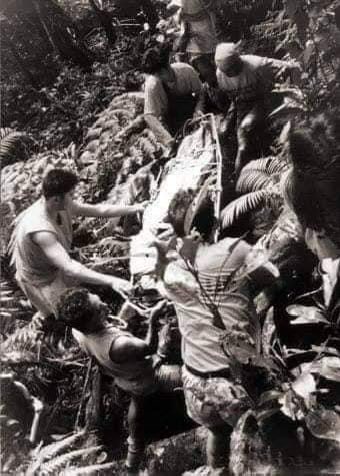
Meanwhile, the Philippine Army organized the rescue team to reach out to the survivors.
I greeted Rilen in her tent. She was still recovering from the infection.
The sun shone brightly today, but the weather remained cool. I called for a meeting with all the survivors and our first responders. After discussion, we decided that John, Bino, Ute, and Ram would lead the survivors to Camp 1, while Ohmar and Philip remained with me. The four of us worked at the rescue camp—cooking, washing, and drying clothes.
The official rescue team was assembled and organized by the Philippine Army. The debriefing happened that night. The MARA, Army personnel, CAFGU, and Sialdang MC were oriented to the search and rescue mission early in the morning of Monday at 3 a.m. They were tasked with bringing food supplies, tents, and a radio for communication.
The rescue team resumed the trek from Lantuyang Camp. Alven De Guzman, Eric Bacarra, Rodrigo Rovira, and Tem Hernandez from Sialdang MC served as the guides for the whole rescue team because they knew the trail and were experienced members of Sialdang MC. MARA Group did not make it before the first water source (Aygatol) and turned back to Lantuyang Camp. They handed the radios to some Army rescuers. After the typhoon, the terrain changed due to landslides. Even the Army aborted the climb to reach the survivors. On the other hand, they handed one radio to Tem Hernandez, the team leader of SMC. Unfortunately, he had an accident. He fell into a ravine while rushing into the forest areas.
Alven, Eric, and Rod hurried to Camp 1 to provide assistance to the survivors. The three rescuers continued their search for survivors who were descending from the Rescue Camp that day and headed towards Camp 2 at the Dulangan River. Fortunately, they spotted the survivors navigating the river’s rapids and boulders, led by Ram, Ute, John, and Bino. The group reunited on the other side of the Dulangan River and replenished their energy with the food the three rescuers had supplied before continuing their climb to Camp 1.
As they approached Camp 1, they noticed a torch and were greeted by various rescue teams, including the Red Cross, BOFs, other climbing organizations, and Mangyans, through a megaphone. The survivors’ tents were located in a sizable camping clearing created by the rescuers. The entire group was relieved to have made it to Camp 1 safely.
The Airlift: October 25, 1994
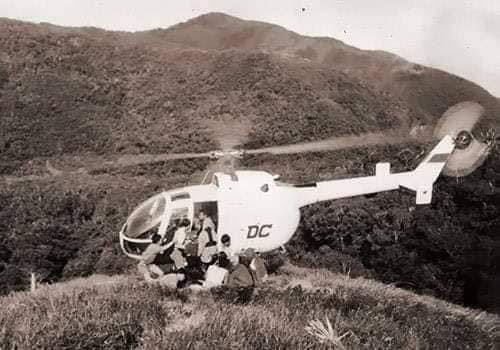
An official chopper was used by the DOH (Department of Health) to airlift the remaining survivors.
Early in the morning, the survivors, rescuers, and other mountain visitors resumed their trek down to Lantuyang. The BOF rescuers were also compelled to descend, and one rescuer from another mountaineering group commented, “Bumaba na kayo, masikip na ang bundok para sa atin!” (Just get down. The mountain is so compact for all of us). He added, we are in charge here.
Meanwhile, at Aplaya (Camp 1), Army Huey helicopters conducted a reconnaissance mission with Sir Ted Infantado, the president of Halcon Mountaineers (HALMS). Although they did not find the exact location, the Huey helicopters returned to Camp 1. Sir Ted invited John Lopez, who knew the location, to join him, and together they were able to locate the survivors in the forest landslide area.
We were resting inside the tent when we heard the helicopter’s rumbling noise. We moved quickly to the clearing area. To get the helicopter’s attention, Ohmar and I waved our hands in the air. Philip crossed his arms in front of his torso to signal for the helicopter to land as the pilot pointed the helicopter towards our camp. The chopper hovered for a few seconds before circling the area twice. It was unable to land due to the presence of trees and a lack of landing space.
Instead, Huey dropped a box of energy-boosting chocolate bars called “power bars,” which sadly got blown away by the wind and landed up in the dense trees. While waiting for the helicopter to return after lunch at the rescue camp, Philip, Ohmar, and I made necklaces from purple utility cords and small stones. We etched the words “Rescue Camp Halcon” into the stones. We made an extra necklace for Rilen.
There were people coming below the rescue camp; I heard their voices talking about the survivors. It was a team of rescuers, including a nurse, who also came to look for Rilen. The nurse administered a vial of Imovane to Rilen. However, the injection had an unexpected effect, leaving Rilen groggy and unable to walk.
Another group, the MOSART (Mountain Search and Rescue Team) 505th Air Force, arrived at the camp and prepared a stretcher to transport Rilen to the nearest clearing. I followed the trail for two hours to Balugbog Baboy, where a Huey helicopter was in the air. However, due to a wind disturbance, it was unable to hover around. Another helicopter was seen in the vicinity, an official chopper used by the DOH (Department of Health) to airlift the remaining survivors. It continuously hovered around and landed safely on the ground, with its left landing skid on the ground and the right skid floating in the air.
The pilot signaled for us to come aboard. One rescuer told me not to fly with them since I looked strong. As I boarded the helicopter, I couldn’t help but feel a mix of emotions. Despite the sarcastic comment from one of the rescuing hikers, we made our way inside the cabin.
As the chopper flew away, I looked down and saw the Balugbog Baboy, a rescue camp, and the ridges of Mt. Halcon up to the summit were still covered with thick, dark clouds. My thoughts were on the Knife Edge, on Neph’s temporary ground. I hid my tears and focused my attention on the long waterlines of the Dulangan River below.
We landed at Calapan Airport. The place was crowded with people and members of the press, eagerly awaiting us. The ambulance and medical teams stood by, ready to transport us. In the vicinity, I could see police, armies, and government officials. Despite the exhaustion and stress, I gathered my strength and prepared to face the crowd. As the airport crew opened the cabin door, a press person approached me, eager for an interview. I politely declined and walked past, following Rilen towards the waiting ambulance. She was assisted by the medical staff. I sat beside her, offering my support. In her hands, she still clutched the stone necklace that Philip had made for her. Looking out of the window, I realized that we were heading to the Provincial Hospital. With a sense of urgency, Rilen was rushed to the emergency room. The hospital staff smiled at me and kindly asked me to wait in the hospital lounge.
The press interviewed me. They asked about the total number of climbers who climbed with me. I informed them that there were thirty climbers, with one still on the Knife Edge. Due to the pain and trauma from the incident, I was unable to answer any further questions. The police ceased the media inquiries, and the medical staff guided me to the hospital lounge. There, the hospital administrator prepared a variety of food from different menus. As I looked around, I saw other survivors sitting on a long couch. They greeted me warmly and hugged me. I searched eagerly for my mountain brothers—Ian, Lyndon, John, Bino, Ute, and Ram—but couldn’t find them. The nurse advised me to eat slowly as I struggled to swallow the food, having only a small appetite. After lunch, the policeman instructed me, along with Philip and Ohmar, to accompany him. We were transported to the Concepcion Beach Resort, where other survivors, rescuers, and friends were waiting for us. In that moment, my thoughts turned to Neph, who was still on the mountain. Suddenly, Mike approached me and burst into tears upon seeing me. I apologized and hugged him tightly.
The Sharp Knife Edge: October 26, 1994
For Mt. Halcon or Mt. Sialdang, the trails hold countless stories. The ground is stained with an abundance of tears. The summit reflects different perspectives, sometimes revealing a sense of masochism. Audacious actions can cause harm, much like the knife edge sharpened by the passage of time.
One of the survivors had a relative in the PSG (Presidential Security Group) and contacted him for technical assistance in retrieving Neph’s body from the Knife Edge. With the help of helicopter assistance, an airlift mission was made possible. A presidential chopper, officially used by President Fidel V. Ramos, arrived for the mission.
The pilot asked me if I wanted to go back for Neph, but I declined to volunteer. Instead, I directed the pilot’s attention to Ian, a strong hiker who had faced extreme weather conditions on the ridge and was under pressure to descend quickly, crossing the rapids of the Dulangan River.
The topographical map was laid out on the table, where the pilots, Ian, and the embalmer studied the location of Neph. Ian marked the map with a red pen. The requested embalmer would then apply a formulated mixture of substances to Neph’s body that would suppress the emitting odor from prolonged exposure to elements.
The MOSART, Ian, and the funeral homeowner/embalmer who were part of the airlift mission were debriefed by the Philippine Air Force. They strategically rehearsed the airlift of Neph’s cadaver in Calapan Airport. There were only a few minutes to execute the intricate plan gracefully. At 8,000 feet, the chopper would land on the Knife Edge, a very delicate task to accomplish. However, Neph’s cadaver was successfully airlifted and brought to the airport to be returned to his family. Some bags containing MOSART equipment were left on the Knife Edge, and they climbed back up the following day to retrieve them.
The Nightmare Encountered at the Peak of Halcon (NEPH), as I consider the horrible event, will remain a traumatic memory for the rest of my life. To handle problems, decisions must be firm. I’ve gained a lot of knowledge from this experience. Thoughts regarding this incident ranged from bad to good, but the lessons must always revolve around safety in general. Knowing that 29 individuals were spared from the nightmare, I can now stand to live and smile.
Several survivors have kept this horrific story buried in their memories for the past 30 years. The author, a survivor who oversaw the mission, has preserved it. The initial press release for MESAU in Action Asia Magazine and the second from a documentary made by the Bedans served as the catalyst for decades of criticism. Sialdang Mountaineers had become silent, supposedly asserting their stories in defense against the attacks being thrown at them. Likewise, the author becomes a target for ridicule in outdoor communities based on the prejudice of the subjective accounts made. This is about the cleansing of the spirits of adventure; thus, it should serve as a stimulant to change in the field, in the mountain scene.
For me in particular, the whole thing was much worse than what happened itself. We had prevailed in the battle up there in the mountains; therefore, I didn’t write this only to win a war. This is to honor the spirit of unity that has endured for so long while social media warriors attempted to establish themselves as superior to the survivors. They create an understanding of their level of superiority among the survivors, even though they were not present during the dreadful incident. It is easy to judge others; apparently, it is difficult to think when the same situation arises.
In 1996, the Mt. Everest tragedy was a profoundly disturbing story, almost the same as the Mt. Halcon tragedy. The nature of death caused by weather abnormalities is the same. Eight mountaineers died on Mt. Everest during a storm, while one hiker died at the Knife Edge of Mt. Halcon. During this turn of events, special technological weather tools are not yet available and supervised in the Philippines.
In terms of outdoor resources, equipment is objectively substandard, unlike nowadays. In battling against the hypothermic condition, or simply the initial experience of the low temperature, Filipinos are not used to it; thus, hypothermia was new and the very first time in mountaineering experience in the tropical region. Simple clothing is not suitable for use with no proper layering concepts, and waterproofing can be fatal to anyone during a storm. Adding to the same dilemma, equipment is relatively heavy, like backpacks, cooksets, tents, shoes, and sleeping systems, and all failed to meet quality standards for high-altitude purposes. Waterproofing and resistance are basic and fundamental in mountaineering. Sadly, all equipment and outdoor resources fall unsafely, which may sound bad in this story.
Outdoor experiences aren’t always enjoyable; they might be arduous and disorganized. The good news is that each new adventure serves as a reminder to take something away from it. We must maintain our composure and remember that we are but a few particles of dust wandering through this natural world.
The paths are full of tales about Mt. Halcon or Mt. Sialdang. The earth is soaked in tears. The peak reflects several points of view, with outdoor life oftentimes depicting masochism. In today’s changing world, outdoor lifestyles depict competition. Everyone likes to engage in outdoor sports. However, competitive activities should not be an attack on personal lives. Once you set foot on the mountain ground, it is the moment to stand as one. Survival depends on inter-dependence. All are leaders in some way. Each can protect and preserve the lives of others along the trail, leading to safety and glory at the summit. Like the Knife Edge that becomes sharper with increased temperature over time, reckless behavior can cause harm to others. That is a simple task and common sense.
The tragedy has taught us lessons. The people not involved in this unfortunate event should also learn to keep their judgment until they hear the stories of the hikers who were at Mt. Halcon. Remember, there are always two sides to a coin, as there are always different versions of the story: the truth and the half-truths, and the lies.
I am ending this with one of my favorite quotes: “Who am I to judge others when I myself walk imperfectly”.
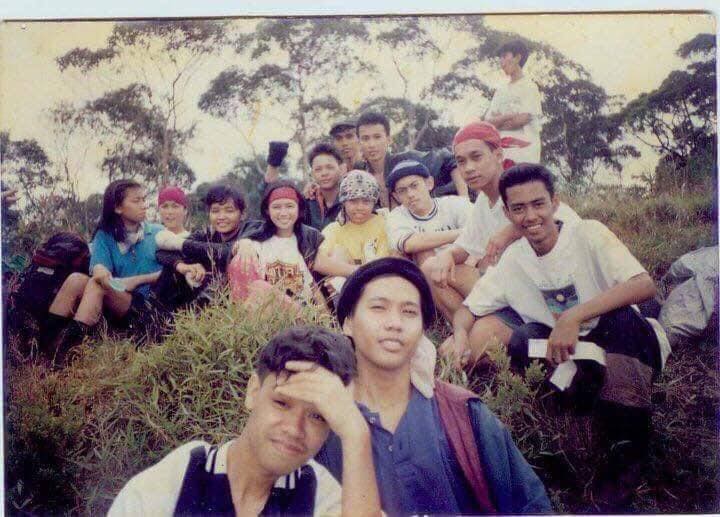

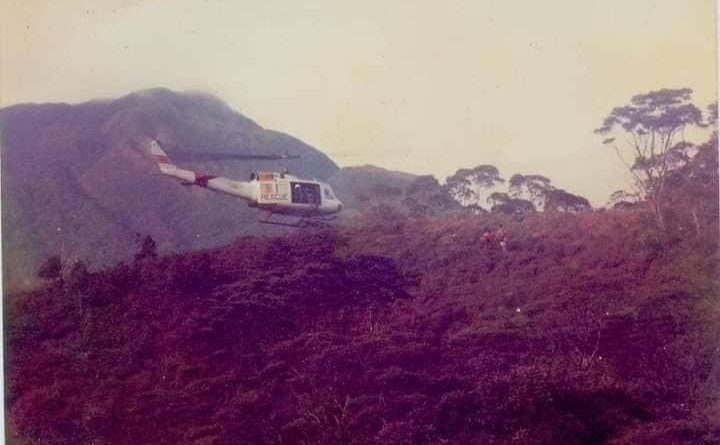

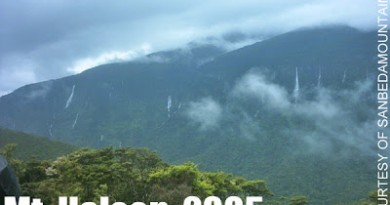
Leave a Reply
Be the First to Comment!